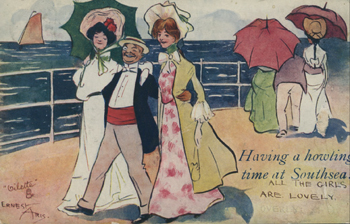Ernest Aris
Prolific writer and illustrator, Ernest Aris, studied for his Diploma in Art at Bradford
Technical College School of Art in 1900.
 Alfred Ernest Walter George Aris was born at 38
Muriel Street, Islington, London, on 22 April 1882 to
lithographic artist Alfred Henry Aris, and his wife Emily
Juliet Wright.
The family moved to Bradford where he attended
the Technical College School of Art, and studied for
his diploma in 1900 under the tutorship of Charles
Stephenson. He later studied at the Royal College of
Art in London.
Alfred Ernest Walter George Aris was born at 38
Muriel Street, Islington, London, on 22 April 1882 to
lithographic artist Alfred Henry Aris, and his wife Emily
Juliet Wright.
The family moved to Bradford where he attended
the Technical College School of Art, and studied for
his diploma in 1900 under the tutorship of Charles
Stephenson. He later studied at the Royal College of
Art in London.
He began his career as a portrait artist and art
teacher, working in watercolour and charcoal and
wash, and exhibited his work at the Royal Academy,
Royal Society of British Artists, Royal Society of
Painters in Watercolours and the Royal Institute of
Painters in Watercolours.
By 1909, Ernest was illustrating for magazines
such as The Graphic and writing and illustrating
children’s books about the antics of anthropomorphic
woodland animals. The illustration exhibited in the
cabinet is from the December 1915 edition of Little
Folks magazine. His illustrations were also used
for advertisements, cigarette cards, games, jigsaw
puzzles and seaside postcards. He was elected to the
membership of the Society of Graphic Artists in 1943.
A prolific writer, Ernest also published his work under
pseudonyms such as ‘Robin A Hood’ and ‘Dan
Crowe’.
In 1934 Cadbury’s commissioned Ernest to design
the ‘Cococubs’, a collection of animal characters to
be given away free with a new line ‘The Children’s
Cocoa’. Initially a collection of 15 brightly painted
lead toy figures manufactured by William Britain’s,
they were such a success the collection was increased
to 32. It was hailed as one of the greatest advertising
schemes of the time, with an estimated 300,000
children collecting them. Ernest also illustrated these
characters in The Cococub News.
Ernest stopped writing books after The Ernest Aris
Nature Series published by Fountain Press and a
drawing manual, The Art of The Pen (1948), but he
continued to illustrate books such as the Tasseltip
Tales (1947-53), a Ladybird series by Dorothy
Richards, The Enid Blyton Book of Brownies, and
Birds of Our Gardens by Enid Blyton.
His illustrations were still being used in a series of
books published by Ladybird in 1989.